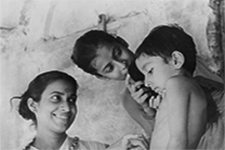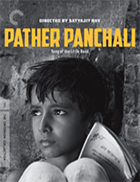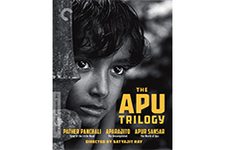Pather Panchali (4K UHD)
|  On any short list of great films about childhood, Satyajit Ray’s directorial debut Pather Pachali (Song of the Little Road) will invariably rank near the top. As one of the first Indian films produced outside the Hindi-language commercial industry located in Bombay, Ray modeled the modestly scaled production aesthetically and thematically on Italian neorealism (he had seen and been deeply affected by Vittorio de Sica’s Bicycle Thieves a few years earlier). Ray first worked as a commercial writer and illustrator of children’s books, so it is not surprising that he was drawn to adapt the first half of Bibhutibhushan Bandyopadhyay’s popular 1929 novel about life in a small, rural village in Bengal that is told largely through the eyes of two children (Ray knew the book well, as he had been assigned to create new illustrations for an abridged version in the mid-1940s). Bandyopadhyay and Ray seemed destined to connect, as the description of Bandyopadhyay in the Encyclopedia of Indian Literature could double as a description of Ray: “known for his power of observation, his profound love of nature, his comprehension of simple men and women including children in particular, and his acute sensibility.” Just as Akira Kurosawa’s Rashomon (1950) opened the figurative gates of Japanese cinema to the West, Pather Panchali was largely responsible for introducing the rest of the world to Indian cinema (which, at the time, was the largest producer of films in the world). The film was a significant critical hit, and it was awarded Best Human Document at the Cannes Film Festival (it was only the second Indian film to play there, the first being Bimal Roy’s Two Acres of Land in 1953). However, it is often overlooked that the film’s also had a powerful, eye-opening impact within India itself, where commercial cinema rarely if ever focused on the Bengali region or characters living in poverty (most Indian films were musicals and melodramas). It was literally one of the first films to depict that aspect of Indian life and invest heavily in the psychological realism of such characters. It was also unique in its stripped down, neorealist aesthetic, an approach that Ray had advocated in “What is Wrong With Indian Cinema?,” an essay he wrote in 1948: “It is only in a drastic simplification of style and content that hope for the Indian cinema resides,” he wrote, which is precisely what he set out to do in Pather Panchali. The film is set entirely in Nischindipur, a small, remote village in Bengal (in keeping with neorealism, the film was shot on location in an actual village named Boral Village). The story centers on the impoverished Ray family: The father, Harihar (Kanu Bannerjee), works as a pujari (priest), but dreams of being a scholar and playwright, while the mother, Sarbojaya (Karuna Bannerjee), maintains their crumbling ancestral home as best she can and tends to their two children: a daughter, Durga (Uma Das Gupta), and a son, Apu (Subir Banerjee). When the film opens, Apu is yet to be born and Durga (then played by Runki Banerjee) is still a young child. The Ray family also takes in Indir (Chunibala Devi), Harihar’s elderly, crippled cousin who Sarbojaya constantly blames for being a burden on the family and their meager resources. As with the novel, there is a wonderfully rambling quality to Pather Panchali as it tracks the daily routines, setbacks, and victories of life in a rural village while also taking time to pause and absorb the lyrical beauty of the nature surrounding them. Issues of finance are a constant, as Sarbojaya struggles to keep everyone in the family fed (food being the primary signifier of wealth here) while Harihar eeks out a living, sometimes travelling for months at a time to find work. There are tensions between the family and some of the other villagers, including the wealthy landowner who accuses Durga of stealing fruit from her orchard, conveniently ignoring the fact that the orchard once belonged to the Ray family. Pather Panchali is not a film of explicit social critique, but it is always there in the subtext, especially in the way Ray frames the world of rural poverty and the desperation many of its characters feel in both staying alive and maintaining some sense of dignity (for this reason I cannot fathom how anyone could accuse Ray of “romanticizing” poverty). Apu, whose growth into a man was depicted in two subsequent films, Aparajito (1956) and Apur Sansar (1959), is largely an observer here: a bright, wide-eyed, largely silent little boy who displays a devious sense of humor and streak of independence that is bested only by Durga, who seems to have an intuitive understanding of her status as an outsider and exploits it by refusing to adhere to others’ rules. Like the so-called “children’s films” of Yasujiro Ozu (particularly 1959’s Good Morning), Pather Panchali uses the world of children to view the adult world from one remove, thus allowing us to better recognize its various failings and hypocrisies. The only adult character who remains resolutely steadfast and largely blameless is Indir. Her status as a “cripple” who is unable to contribute to conventional adult life effectively isolates her with the children, which is why she is so predisposed to taking their side in disputes with their parents. Sarbojaya can be downright cruel at times, especially in her treatment of Indir, while Harihar is a distracted dreamer whose focus on his own actualization as a scholar and writer often come at his family’s expense. There are also numerous secondary characters in the village, including the landowner and the abusive schoolteacher/grocer, who represent various moral failings. However, the critical aspect of Pather Panchali regularly takes a backseat to the film’s simple charms, which seem so effortless that it is difficult to believe that Ray was making his directorial debut. He had spent significant time planning the film, and there were numerous setbacks and delays during production due to financial constraints. At one point he had to hawk his wife’s jewelry to pay for a few more days of shooting, and he eventually had to pause production for almost a year when they ran out of money, a problem that was eventually solved when the West Bengal state government funded the film’s completion as a “community development project.” Shot in a stark black and white with compositions and camera movements that are elegant and unassuming, Pather Panchali easily stands with the best of the Italian neorealist films that inspired it. The film has a heartfelt quality that emerges from Ray’s humanistic treatment of his characters, warts and all. As Pauline Kael wrote, “I think that Ray, like Kurosawa, is one of the great new film masters, and that his simplicity is a simplicity arrived at, achieved, a master’s distillation of experience.” For Kael, Ray’s art was “art which seeks to illuminate experience and help us feel.” Thus, Pather Panchali is simple, but not a simplistic, and it is hardly a romanticized paean to childhood, although there are moments of great beauty that remind us how wonderful the world can be when it is stripped of the weight of social responsibility. Ray handles the moments of beauty and moments of tragedy with a deft touch. The specter of death is always haunting the edges of the frame, and it makes it presence known twice in the film. Ray stages grief and tragedy with great emotional power, never so much as when one character learns of another character’s death at a moment of personal elation and pride, thus bringing into direct conflict the film’s careful, lyrical balance between the joyful and the tragic.
Copyright © 2024 James Kendrick Thoughts? E-mail James Kendrick All images copyright © The Criterion Collection | |||||||||||||||||||||||||||||
Overall Rating: 


 (4)
(4)


 Pather Panchali is available as part of The Criterion Collection’s “The Apu Trilogy” 4K UHD + Blu-ray boxset, which also includes Aparajito (1956) and Apur Sansar (1959).
Pather Panchali is available as part of The Criterion Collection’s “The Apu Trilogy” 4K UHD + Blu-ray boxset, which also includes Aparajito (1956) and Apur Sansar (1959).